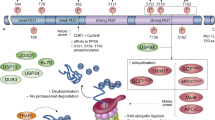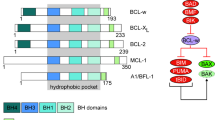Abstract
Bcl-2 is an oncogenic protein that acts by inhibiting programmed cell death. The mechanisms used by this and related anti-apoptotic proteins to protect cells from cytotoxic stimuli are now emerging, with the discovery that Bcl-2 can function both as an ion channel and as an adaptor or docking protein.
This is a preview of subscription content, access via your institution
Access options
Subscribe to this journal
Receive 51 print issues and online access
$199.00 per year
only $3.90 per issue
Buy this article
- Purchase on Springer Link
- Instant access to full article PDF
Prices may be subject to local taxes which are calculated during checkout



Similar content being viewed by others
References
Tsujimoto, Y. & Croce, C. M. Analysis of the structure, transcripts, and protein products of bcl-2, the gene involved in human follicular lymphoma. Proc. Natl Acad. Sci. USA 83, 5214–5218 (1986).
Muchmore, S. W. et al. X-ray and NMR structure of human Bcl-xL, an inhibitor of programmed cell death. Nature 381, 335–341 (1996).
Baffy, G., Miyashita, T., Williamson, J. R. & Reed, J. C. Apoptosis induced by withdrawal of interleukin-3 (IL-3) from an IL-3-dependent hematopoietic cell line is associated with repartitioning of intracellular calcium and is blocked by enforced Bcl-2 oncoprotein production. J. Biol. Chem. 268, 6511–6519 (1993).
Lam, M. et al. Evidence that Bcl-2 represses apoptosis by regulating endoplasmic reticulum-associated Ca2+fluxes. Proc. Natl Acad. Sci. USA 91, 6569–6573 (1994).
Ryan, J. J. et al. c-myc and bcl-2 modulate p53 function by altering p53 subcellular trafficking during the cell cycle. Proc. Natl Acad. Sci. USA 91, 5878–5882 (1994).
Minn, A. J. et al. Bcl-xLforms an ion channel in synthetic lipid membranes. Nature 385, 353–357 (1997).
Schendel, S. L. et al. Channel formation by anti-apoptotic protein, Bcl-2. Proc. Natl Acad. Sci. USA 94, 5113–5118 (1997).
Montal, M. Protein folds in channel structure. Curr. Opin. Struct. Biol. 6, 499–510 (1996).
Chen, J. et al. bcl-2 overexpression reduces apoptotic photoreceptor cell death in three different retinal degenerations. Proc. Natl Acad. Sci. USA 93, 7042–7047 (1996).
Middleton, G., Nunez, G. & Davies, A. M. Bax promotes neuronal survival and antagonises the survival effects of neurotrophic factors. Development 122, 695–701 (1996).
Kiefer, M. C. et al. Modulation of apoptosis by the widely distributed Bcl-2 homologue Bak. Nature 374, 736–739 (1995).
Bernardi, P., Broekemeier, K. M. & Pfeiffer, D. R. Recent progress on regulation of the mitochondrial permeability transition pore; a cyclosporin-sensitive pore in the inner mitochondrial membrane. J. Bioenerget. Biomembr. 26, 509–517 (1994).
Zoratti, M. & Szabo, I. Electrophysiology of the inner mitochondrial membrane. J. Bioenerget. Biomembr. 26, 543–553 (1996).
Petit, P. X., Susin, S.-A., Zamzami, N., Mignotte, B. & Kroemer, G. Mitochondria and programmed cell death: back ot the future. FEBS Lett. 396, 7–13 (1996).
Susin, S. A. et al. Bcl-2 inhibits the mitochondrial release of an apoptogenic protease. J. Exp. Med. 184, 1331–1342 (1996).
Xiang, J., Chao, D. T. & Korsmeyer, S. J. BAX-induced cell death may not require interleukin 1β-converting enzyme-like proteases. Proc. Natl Acad. Sci. USA 93, 14559–14563 (1996).
Kluck, R. M., Bossy-Wetzel, E., Green, D. R. & Newmeyer, D. D. The release of cytochrome c from mitochondria: a primary site for Bcl-2 regulation of apoptosis. Science 275, 1132–1136 (1997).
Yang, J. et al. Prevention of apoptosis by Bcl-2: release of cytochrome c from mitochondria blocked. Science 275, 1129–1132 (1997).
Häcker, G. & Vaux, D. L. Asticky business. Curr. Biol. 5, 622–624 (1995).
Yuan, J. Y. & Horvitz, H. R. The Caenorhabditis elegans genes ced-3 and ced-4 act cell autonomously to cause programmed cell death. Dev. Biol. 138, 33–41 (1990).
Shaham, S. & Horvitz, H. R. Developing Caenorhabditis elegans neurons may contain both cell-death protective and killer activities. Genes Dev. 10, 578–591 (1996).
Spector, M. S., Desnoyers, S., Heoppner, D. J. & Hengartner, M. O. Interaction between the C. elegans cell-death regulators CED-9 and CED-4. Nature 275, 1122–1126 (1997).
Chinnaiyan, A. M., O'Rourke, K., Lane, B. R. & Dixit, V. M. Interaction of CED-4 with CED-3 and CED-9: a molecular framework for cell death. Science 275, 1122–1126 (1997).
Wu, D., Wallen, H. D. & Nunez, G. Interaction and regulation of subcellular localization of CED-4 by CED-9. Science 275, 1126–1129 (1997).
Shaham, S. & Horvitz, H. R. An alternatively spliced C. elegans ced-4 RNA encodes a novel cell death inhibitor. Cell 86, 201–208 (1996).
Wang, H. G., Rapp, U. R. & Reed, J. C. Bcl-2 targets the protein kinase Raf-1 to mitochondria. Cell 87, 629–638 (1996).
Zha, J., Harada, H., Yang, E., Jockel, J. & Korsmeyer, S. J. Serine phosphorylation of death agonist BAD in response to survival factor results in binding to 14-3–3 not BCL-XL. Cell 87, 619–628 (1996).
Wang, H.-G., Takayama, S., Rapp, U. R. & Reed, J. C. Bcl-2 interacting protein, BAG-1, binds to and activates the kinase Raf-1. Proc. Natl Acad. Sci. USA 93, 7063–7068 (1996).
Sattler, M. et al. Structure of Bcl-xL–Bak peptide complex: recognition between regulators of apoptosis. Science 275, 983–986 (1997).
Diaz, J.-L. et al. Acommon binding site mediates heterodimerization and homodimerization of Bcl-2 family members. J. Biol. Chem. 272, 11350–11355 (1997).
Shibasaki, F., Kondo, E., Akagi, T. & McKeon, F. Suppression of signalling through NF-AT by interactions between calcineurin and Bcl-2. Nature 386, 728–731 (1997).
Shibasaki, F. & McKeon, F. Calcineurin functions in Ca2+-activated cell death in mammalian cells. J. Cell Biol. 131, 735–743 (1995).
Pietenpol, J. A. et al. Paradoxical inhibition of solid tumor cell growth by bcl-2. Cancer Res. 54, 3714–3717 (1994).
Linette, G. P., Li, Y., Roth, K. & Korsmeyer, S. J. Cross talk between cel death and cell cycle progression: BCL-2 regulates NFAT-medicated activation. Proc. Natl Acad. Sci. USA 93, 9545–9552 (1996).
Huang, D. C. S., O'Reilly, L. A., Strasser, & Cory, S. The anti-apoptosis function of Bcl-2 can be genetically separated from its inhibitory effect on cell cycle entry. EMBO J.(in the press).
Haldar, S., Jena, N. & Croce, C. M. Inactivation of Bcl-2 by phosphorylation. Proc. Natl Acad. Sci. USA 92, 4507–4511 (1995).
Chang, B. S., Minn, A. J., Muchmore, S. W., Fesik, S. W. & Thompson, C. B. Identification of a novel regulatory domain in Bcl-xLand Bcl-2. EMBO J. 16, 968–977 (1997).
Naumovski, L. & Cleary, M. L. The p53-binding protein 53BP2 also interacts with Bcl-2 and impedes cell cycle progression at G2/M. Mol. Cell. Biol. 16, 3884–3892 (1996).
Krajewski, S. et al. Investigations of the subcellular distribution of the bcl-2 oncoprotein: residence in the nuclear envelope, endoplasmic reticulum, and outer mitochondrial membranes. Cancer Res. 53, 4701–4714 (1993).
Kane, D. J., örd, T., Anton, R. & Bredesen, D. E. Expression of Bcl-2 inhibits necrotic neural cell death. J. Neurosci. Res. 40, 269–275 (1995).
Acknowledgements
I thank M. Montal, S. Schendel and S. Choe for discussions on channel proteins, and D. Bredesen and G. Salvesen for critically reviewing the manuscript.
Author information
Authors and Affiliations
Rights and permissions
About this article
Cite this article
Reed, J. Double identity for proteins of the Bcl-2 family. Nature 387, 773–776 (1997). https://doi.org/10.1038/42867
Issue Date:
DOI: https://doi.org/10.1038/42867
This article is cited by
-
Anti-apoptotic protein Bcl-2 contributes to the determination of reserve cells during myogenic differentiation of C2C12 cells
In Vitro Cellular & Developmental Biology - Animal (2024)
-
Anti-tumor activity of resveratrol against gastric cancer: a review of recent advances with an emphasis on molecular pathways
Cancer Cell International (2021)
-
Melatonin and vitamin E alleviate homocysteine‐induced oxidative injury and apoptosis in endothelial cells
Molecular Biology Reports (2020)
-
Human proximal tubular cells can form calcium phosphate deposits in osteogenic culture: role of cell death and osteoblast-like transdifferentiation
Cell Death Discovery (2019)
-
Novel ethanocycloheptono [3,4,5-kl]benzo[a]xanthene induces apoptosis in BEL-7402 cells
Molecular and Cellular Biochemistry (2018)
Comments
By submitting a comment you agree to abide by our Terms and Community Guidelines. If you find something abusive or that does not comply with our terms or guidelines please flag it as inappropriate.



